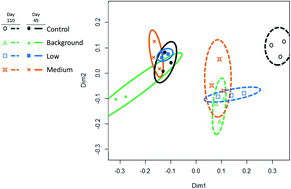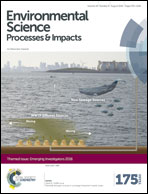Chronic exposure to triclosan sustains microbial community shifts and alters antibiotic resistance gene levels in anaerobic digesters†
Abstract
Triclosan, an antimicrobial chemical found in consumer personal care products, has been shown to stimulate antibiotic resistance in pathogenic bacteria. Although many studies focus on antibiotic resistance pertinent to medical scenarios, resistance developed in natural and engineered environments is less studied and has become an emerging concern for human health. In this study, the impacts of chronic triclosan (TCS) exposure on antibiotic resistance genes (ARGs) and microbial community structure were assessed in lab-scale anaerobic digesters. TCS concentrations from below detection to 2500 mg kg−1 dry solids were amended into anaerobic digesters over 110 days and acclimated for >3 solid retention time values. Four steady state TCS concentrations were chosen (30–2500 mg kg−1). Relative abundance of mexB, a gene coding for a component of a multidrug efflux pump, was significantly higher in all TCS-amended digesters (30 mg kg−1 or higher) relative to the control. TCS selected for bacteria carrying tet(L) and against those carrying erm(F) at concentrations which inhibited digester function; the pH decrease associated with digester failure was suspected to cause this selection. Little to no impact of TCS was observed on intI1 relative abundance. Microbial communities were also surveyed by high-throughput 16S rRNA gene sequencing. Compared to the control digesters, significant shifts in community structure towards clades containing commensal and pathogenic bacteria were observed in digesters containing TCS. Based on these results, TCS should be included in studies and risk assessments that attempt to elucidate relationships between chemical stressors (e.g. antibiotics), antibiotic resistance genes, and public health.

- This article is part of the themed collection: Emerging Investigators 2016

 Please wait while we load your content...
Please wait while we load your content...